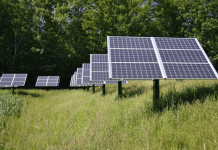In today's world, green tech renewables quietly lead the charge in our battle against climate change. This article explores seven innovative technologies that, though unobtrusive, wield significant influence in purifying our planet.
From harnessing solar and wind power to tapping into geothermal energy and ocean forces, these innovations reshape our energy landscape, leaving a cleaner, greener footprint on Earth. Join us in uncovering the marvels of green tech renewables.
Solar Power
Solar panels, equipped with photovoltaic cells, harness sunlight to generate electricity. This renewable energy source reduces dependency on fossil fuels, thereby decreasing greenhouse gas emissions and contributing to a cleaner environment.
Solar power aligns with the global shift toward sustainable and eco-friendly energy alternatives.
Advantages of Solar Energy
- Renewable and abundant: Solar energy is an infinite and widely available resource.
- Environmentally friendly: Solar power is clean, producing no greenhouse gases or pollutants.
- Low operating costs: Once installed, solar panels require minimal maintenance and offer long-term savings.
- Energy independence: Solar allows you to reduce reliance on external energy sources.
- Grid stability: Distributed solar helps stabilize the electrical grid during peak demand.
Environmental Impact
- Reduced greenhouse gas emissions
- Decreased air and water pollution
- Lower carbon footprint
- Conservation of natural resources
- Minimal land disturbance

Wind Energy
Wind energy utilizes wind turbines to transform kinetic energy from moving air into electricity, offering a dependable and renewable power source.
This eco-friendly technology significantly reduces carbon emissions, creating a greener and more sustainable energy landscape. Wind power aligns with the global push for cleaner, more reliable energy solutions.
Advantages of Wind Energy
- Renewable and abundant: Sustainable and widely available
- Environmentally friendly: Clean and no greenhouse gas emissions
- Low operating costs: Cost-effective and minimal maintenance
- Energy independence: Reduced reliance on external sources
- Grid stability: Enhances electrical grid reliability
Eco-friendly Contributions
- Reduces air pollution
- Conserves water resources
- Protects wildlife habitats
- Lowers carbon footprint
- Minimizes land disturbance
Hydroelectric Power
Hydroelectric dams generate electricity from flowing water via turbines. This renewable energy source supplies power while reducing greenhouse gas emissions. It plays a pivotal role in sustainable energy production.
Advantages of Hydroelectric Power
- Renewable and reliable: Sustainable and dependable.
- Low greenhouse gas emissions: Minimizes carbon footprint.
- Efficient energy generation: Highly effective at converting water's energy.
- Flood control and water storage: Manages water, prevents floods, and stores water.
- Long operational life: Provides consistent power for decades.
Environmental Benefits
- Reduced air pollution
- Minimal greenhouse gas emissions
- Preserved aquatic ecosystems
- Low impact on natural landscapes
- Enhanced water quality
Geothermal Energy
Geothermal energy taps into the Earth's natural heat from within to produce electricity and heat buildings.
It's a sustainable and environmentally friendly energy source with minimal emissions, offering reliable power and heating solutions.
Advantages of Geothermal Energy
- Renewable and constant heat source: Utilizes Earth's heat from within, an everlasting energy source.
- Low greenhouse gas emissions: Produces minimal carbon emissions, reducing environmental impact.
- Minimal land use: Requires a small footprint compared to other energy sources.
- Reliable and consistent power generation: Offers dependable electricity production unaffected by weather conditions.
- Sustainable heating and cooling: Provides energy-efficient solutions for heating and cooling buildings.
Sustainability Impact
- Reduced reliance on fossil fuels.
- Decreased greenhouse gas emissions.
- Minimal water usage.
- Enhanced energy security.
- Long-term resource availability.
Biomass Energy
Biomass energy harnesses organic materials like wood, crop residues, and waste to produce heat and electricity.
It's a renewable and environmentally friendly energy source that reduces waste and provides sustainable alternatives for heating, electricity generation, and fuel production.
Advantages of Biomass Energy
- Renewable resource: Sustainable and replenishable.
- Reduces waste: Utilizes organic waste, reducing disposal problems.
- Low greenhouse gas emissions: Minimizes carbon emissions.
- Diverse feedstock: Sourced from various materials, offering production flexibility.
- Local economic benefits: Creates jobs and supports local economies.
Sustainable Contributions
- Waste reduction
- Renewable resource
- Carbon-neutral
- Local job creation
- Energy independence

Tidal and Wave Energy
Tidal and wave energy harness the power of ocean tides and waves to generate electricity.
These renewable energy sources offer predictable and consistent energy production, contributing to a sustainable and clean energy future while minimizing environmental impact.
Advantages of Tidal and Wave Energy
- Renewable and predictable: Consistent and sustainable energy sources from ocean movements
- Low environmental impact: Minimal greenhouse gas emissions and reduced harm to marine ecosystems
- Energy security: Reduces reliance on fossil fuels, enhancing energy independence
- Predictable energy generation: Accurate forecasting of tides and waves ensures reliable power production
- Reduced land use: Requires less land compared to some other renewable energy sources
Oceanic Environmental Benefits
- Marine ecosystem preservation
- Reduced air and water pollution
- Mitigated ocean acidification
- Minimal habitat disruption
- Lower carbon footprint
Electric Vehicles
Electric vehicles (EVs) run on rechargeable batteries, emitting zero tailpipe emissions. They're an eco-friendly, energy-efficient alternative to gas-powered cars, reducing air pollution and fossil fuel dependence.
Advantages of Electric Vehicles
- Zero emissions: Produce no tailpipe pollutants
- Energy efficiency: High conversion efficiency
- Low maintenance: Fewer moving parts, reduced upkeep
- Reduced greenhouse gases: Lower carbon footprint
- Instant torque: Quick acceleration for improved performance
Reduction of Greenhouse Gas Emissions
- Renewable energy adoption
- Energy-efficient appliances
- Public transportation
- Sustainable agriculture
- Reforestation efforts
The Future of Green Tech Renewables: Trends and Innovations to Watch
The future of green tech renewables is an exciting landscape of innovation and sustainability. As we strive to reduce our carbon footprint and combat climate change, new trends and innovations emerge to reshape how we harness clean energy.
Here are some key trends and innovations to watch:
- Advanced Solar Technologies: Next-generation solar panels and advanced photovoltaic systems are increasing efficiency and affordability, making solar energy even more accessible.
- Energy Storage Breakthroughs: Enhanced energy storage solutions, such as advanced batteries and grid-scale storage, are revolutionizing how we store and distribute renewable energy.
- Wind Power Evolution: Innovative turbine designs and offshore wind farms are expanding the potential of wind energy, offering more reliable and efficient power generation.
- Smart Grids and Energy Management: Smart grids and energy-efficient technologies optimize energy distribution and consumption, reducing waste and environmental impact.
- Electrification of Transportation: The rise of electric vehicles and improved charging infrastructure is reshaping the automotive industry and reducing greenhouse gas emissions.
- Sustainable Materials and Biofuels: Developments in sustainable materials and biofuels are making renewable energy more environmentally friendly.
- International Collaboration: Global cooperation and agreements are fostering the growth of green tech renewables globally, promoting a cleaner future for all.
These trends and innovations drive the evolution of green tech renewables, offering hope for a more sustainable and environmentally friendly world.
Wrap-Up: How the Top 7 Green Tech Renewables Quietly Clean Our Planet
In conclusion, the top 7 green tech renewables featured here are the silent architects of a cleaner, more sustainable future.
From solar panels to wind turbines, geothermal energy to biomass, tidal and wave power to electric vehicles, these technologies work tirelessly to reduce reliance on fossil fuels, combat climate change, and protect ecosystems.
Government incentives further bolster their adoption, paving the way for a greener world that is not only cleaner and quieter but also more sustainable for generations to come.



